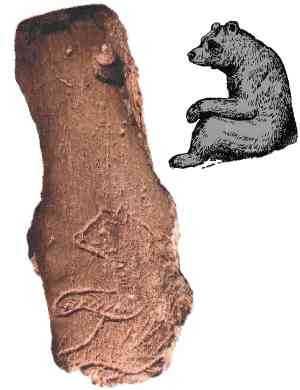
|

|
In the spring of 1874 two very unusual bones were found during the archaelogical excavation of a Swiss cave called Kesslerloch. One bone (shown above, on the left) bore the crude image of a sitting bear. The other bone bore the image of a fox.
During the previous months many Stone Age implements had already been found in the cave. When the worker who found the bones, Albert Stamm, presented them to the two men leading the dig, Albert Heim and Konrad Merk, they grew excited because the carved bones were quite unlike any other Stone Age tools ever found. As Merk noted in the paper he later published about the bones, the carvings lacked the "grace and correctness" of most Stone Age images. Nevertheless, no one doubted that they were real.
Two years later, in 1876, a rival scientist named Ludwig Lindenschmitt made a stunning discovery. He realized that the images of the bear and the fox that graced the bones had actually been crudely copied from a children's book that his son happened to be reading. The picture of the sitting bear that Lindenschmitt found in the German children's book is shown above.
The perpetrator of the hoax turned out to be Albert Stamm, the worker who had originally presented the bones to Heim and Merk. Stamm, hoping to earn the bonus customarily paid to workers for extraordinary finds, had enlisted a friend to carve pictures on some bones. His friend had then turned to the children's book for inspiration.